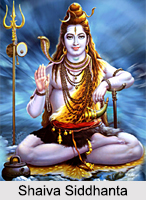 Shaiva Siddhanta was a Shaivite Hindu school. Shaiva Siddhanta flourished in Kashmir from 8th to 11th Centuries. A radically modified descendent survives till today in South India as a devotional religion. Ramakantha Bhatta was one of its important thinkers. After the 12th Century, this cult was rare in North India. The school appears to have died out in other parts of India even though its importance grew in the south especially in Tamil Nadu. Shaiva Siddhanta is rich in its traditions related to the temples, religious festivals, sacred arts, spiritual culture, priesthood, monastic orders and spiritual lineages.
Shaiva Siddhanta was a Shaivite Hindu school. Shaiva Siddhanta flourished in Kashmir from 8th to 11th Centuries. A radically modified descendent survives till today in South India as a devotional religion. Ramakantha Bhatta was one of its important thinkers. After the 12th Century, this cult was rare in North India. The school appears to have died out in other parts of India even though its importance grew in the south especially in Tamil Nadu. Shaiva Siddhanta is rich in its traditions related to the temples, religious festivals, sacred arts, spiritual culture, priesthood, monastic orders and spiritual lineages.
Literary Sources of Shaiva Siddhanta
The Shaiva Siddhanta tradition draws its authority from the 28 Shaiva Agamas, the devotional works of several saints of Shaivism, and the writings of several thinkers and scholars. The first known guru of Shaiva Siddhanta tradition was Nandinatha, who lived around 250 BC. He left behind a compilation of 26 Sanskrit verses called the "Nandikeswara Kasika", in which he laid down the basic tenets of Shaiva Siddhanta School.
Significance of Lord Shiva in Shaiva Siddhanta
Lord Shiva is considered as a deity with an interest in the world that is sympathetically disposed towards inborn defect human beings. He possesses an unlimited power comprising knowledge and action. He is all pervasive. He is never subject to finite conditions. Inborn fault is a material substance and an action is needed to remove it. Knowledge of its presence is not enough. The eternally real material cause of the physical universe is called Maya. Lord Shiva operates on this to create environments so that souls embodied with limited powers of knowledge and action may be freed from their karta by experiencing its fruits. The Shaiva Siddhantins hold that creation and the organisation of spheres of experience is in agreement with the accumulated karma of individuals. The soul will be released at death when the effects of its past karma have been worn out
Practice of Shaiva Siddhanta
Following the ritual path just for its own sake will not generate karma. It helps to remove an innate defect that has radically restricted the souls" infinite innate powers of knowledge and action. This is ultimately responsible for subjection to Karma and rebirth. Salvation granted by Lord Shiva is understood as becoming all powerful and all knowing like the Supreme.
The Siddhanta tradition differs from the Vedic and Puranic cult of Shiva due to its adherence to texts called "Agamas" which lay down rites that may be performed by any able man in his prime and describe a progressive, fourfold spiritual path of virtuous and moral living. Shaiva Siddhanta"s original form is not certain. The rituals are conducted as per the Agama Shastras.
Today, there are trustees of almost all the Lord Shiva temples of Tamil Nadu.




















